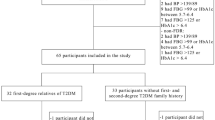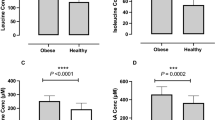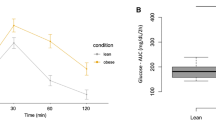Abstract
Aim: To compare the insulin sensitivity indices between Chinese vegetarians and omnivores.
Methods: The study included 36 healthy volunteers (vegetarian, n=19; omnivore, n=17) who had normal fasting plasma glucose levels. Each participant completed an insulin suppression test. We compared steady-state plasma glucose (SSPG), fasting insulin, the homeostasis model assessment for insulin sensitivity (HOMA-IR and HOMA %S) and β-cell function (HOMA %β) between the groups. We also tested the correlation of SSPG with years on a vegetarian diet.
Results: The omnivore subjects were younger than the vegetarians (55.7±3.7 vs 58.6±3.6 year of age, P=0.022). There was no difference between the two groups in sex, blood pressure, renal function tests and lipid profiles. The omnivores had higher serum uric acid levels than vegetarians (5.25±0.84 vs 4.54±0.75 mg/dl, P=0.011). The results of the indices were different between omnivores and vegetarians (SSPG (mean±s.d.) 105.4±10.2 vs 80.3±11.3 mg/dl, P<0.001; fasting insulin, 4.06±0.77 vs 3.02±1.19 μU/ml, P=0.004; HOMA-IR, 6.75±1.31 vs 4.78±2.07, P=0.002; HOMA %S, 159.2±31.7 vs 264.3±171.7%, P=0.018) except insulin secretion index, HOMA %β (65.6±18.0 vs 58.6±14.8%, P=0.208). We found a clear linear relation between years on a vegetarian diet and SSPG (r=−0.541, P=0.017).
Conclusions: The vegetarians were more insulin sensitive than the omnivore counterparts. The degree of insulin sensitivity appeared to be correlated with years on a vegetarian diet.
This is a preview of subscription content, access via your institution
Access options
Subscribe to this journal
Receive 12 print issues and online access
$259.00 per year
only $21.58 per issue
Buy this article
- Purchase on Springer Link
- Instant access to full article PDF
Prices may be subject to local taxes which are calculated during checkout

Similar content being viewed by others
References
American Diabetes Association (1997): Report of the expert committee on the diagnosis and classification of diabetes mellitus. Diabetes care 20, 1183–1197.
Arcaro G, Cretti A, Balzano S, Lechi A, Muggeo M, Bonora E & Bonadonna RC (2002): Insulin causes endothelial dysfunction in Humans. Circulation 105, 576–582.
Chang-Claude J, Frentzel-Beyme R & Eilber U (1992): Mortality pattern of German vegetarians after 11 years of follow-up. Epidemiology 3, 395–401.
DeFronzo RA & Ferrannini E (1991): Insulin resistance: a multifaceted syndrome response for NIDDM, obesity, hypertension, dyslipidemia, and atherosclerotic cardiovascular disease. Diabetes Care 14, 173–194
DeFronzo RA (1988): The triumvirate: beta-cell, muscle, liver. A collusion responsible for NIDDM. Diabetes 37, 667–687.
Diabetes Prevention Program Research Group (2002): Reduction in the incidence of type 2 diabetes with lifestyle intervention or metformin. N Engl J Med 346, 393–403.
Greenfield MS, Doberne L, Kraemer F, Tobey T & Reaven GM (1981): Assessment of insulin resistance with the insulin suppression test and euglycemic clamp. Diabetes 30, 387–392.
Hu FB, Manson JE, Stampfer MJ, Colditz G, Liu S, Solomon CG & Willett WC (2002): Diet, lifestyle, and the risk of type 2 diabetes mellitus in women. N. Engl. J. Med. 345, 790–797.
Hwu CM, Kwok CF, Kuo CS, Hsiao LC, Lee YS, Weih MJ, Kao WY, Lee SH & Ho LT (2002): Exacerbation of insulin resistance and postprandial triglyceride response in newly diagnosed hypertensive patients with hypertriglyceridaemia. J. Hum. Hypertens. 16, 487–493.
Kuo CS, Hwu CM, Kwok CF, Hsiao LC, Weih MJ, Lee SH & Ho LT (2000): Using semi-automated oscillometric blood pressure measurement in diabetic patients and their offspring. J. Diabetes Complicat. 14, 288–293.
Kuo CS, Hwu CM, Chiang SC, Hsiao LC, Weih MJ, Kao WY, Lee SH, Kwok CF & Ho LT (2002): Waist circumference predicts insulin resistance in offspring of diabetic patients. Diabetes Nut. Metab. 15, 101–108.
Kuo CS, Hwu CM, Kwok CF, Hsiao LC, Weih MJ, Lee SH, Lee YS & Ho LT (2002): Surrogate estimates of insulin sensitivity in Chinese diabetic patients and their offspring. Diabetes Med. 19, 735–740.
Laakso M (1993): How good a marker is insulin level for insulin resistance? Am. J. Epidemiol. 137, 959–965.
Levy JC, Matthews DR & Hermans MP (1998): Correct homeostasis model assessment (HOMA) evaluation uses the computer program. Diabetes Care 21, 2191–2192.
Lichtenstein AH & Schwab US (2000): Relationship of dietary fat to glucose metabolism. Atheroscelrosis 150, 227–243.
Lin CL, Fang TC & Gueng MK (2001): Vascular dilatory functions of ovo-lactovegetarians compared with omnivores. Atherosclerosis 158, 247–251.
Lin CL, Huang JF, Lin YC, Huang CY & Lin PY (1997): Acceptability of lacto-ovovegetarian diet by patients at Tzu-Chi general hospital. Tzu Chi. Med. J. 9, 199–206.
Lin CL (1997): Vegetarianism. Tzu Chi. Med. J. 9, 81–89.
Lu SC, Wu WH, Lee CA, Chou HF, Lee HR & Huang PC (2000): LDL of Taiwanese vegetarians are less oxidizable than those of omnivores. Am. J. Clin. Nutr. 130, 1591–1596.
Margetts BM, Armstrong BK, Bekin LJ & Vandongen R (1986): Vegetarian diet in mild hypertension: a randomized controlled trial. BMJ 293, 1468–1471.
Matthews DR, Hosker JP, Rudenski AS, Naylor BA, Treacher DF & Turner RC (1985): Homeostasis model assessment: insulin resistance and β-cell function from fasting plasma glucose and insulin concentrations in man. Diabetologia 28, 412–419.
Moller DE & Flier JS (1991): Insulin resistance: mechanism, syndrome, and implications. N. Engl. J. Med. 325, 938–948.
Nutrition and Health Survey in Taiwan, NAHSIT, 1993–1996 (1999): Department of Health, the Executive Yuan, Taipei, Taiwan, pp 89–113.
Pan WH, Chin CJ, Sheu CT & Lee MH (1993): Haemostatic factors and blood lipids in young Buddhist vegetarians and omnivores. Am. J. Clin. Nutr. 58, 354–359.
Pan XR, Li GW, Hu YH, Wang JX, Yang WY, An ZX, Hu ZX, Lin J, Xiao JZ, Cao HB, Liu PA, Jiang XG, Jiang YY, Wang JP, Zheng H, Zhang H, Bennett PH & Howard BV (1997): Effects of diet and exercise in preventing NIDDM in people with impaired glucose tolerance: the Da Qing IGT and Diabetes Study. Diabetes Care 20, 537–544.
Phillips RL, Kuzma JW, Beeson LW & Lotz T (1980): Influence of selection versus lifestyle on risk of fatal cancer and cardiovascular disease among Seven-Day adventisits. Am. J. Epidemiol. 112, 296–314.
Reaven GM & Olefsky JM (1977): Relationship between heterogeneity of insulin responses and insulin resistance in normal subjects and patients with chemical diabetes. Diabetologia 13, 201–206.
Reaven GM (1988): Role of insulin resistance in human disease. Diabetes 37, 1595–1607.
Rich MW (2000): Uric acid: is it a risk factor for cardiovascular disease? Am. J. Cardiol. 85, 1018–1021.
Scheen AJ, Paquot N, Castillo MJ & Lefebvre PJ (1994): How to measure insulin action in vivo. Diabetes Metab. Rev. 10, 151–188.
Sokal RR & Rohlf FJ (1994): Biometry: The Principles and Practice of Statistics in Biological research, 3rd edition. New York: W. H. Freeman and Company.
Storlien LH, Jenkins AB, Chisholm DJ, Pascoe WS, Khouri S & Kraegen EW (1991): Influence of dietary fat composition on development of insulin resistance in rats. Relationship to muscle triglyceride and ω-3 fatty acids in muscle phopholipid. Diabetes 40, 280–289.
Summers LK, Fielding BA, Bradshaw HA et al (2002): Substituting dietary saturated fat with polyunsaturated fat changes abdominal fat distribution and improves insulin sensitivity. Diabetologia 45, 369–377.
Tsunoda S, Kamide K, Minami J & Kawano Y (2002): Decreases in serum uric acid by amelioration of insulin resistance in overweight hypertensive patients: effect of a low-energy diet and an insulin-sensitizing agent. Am. J. Hypertens. 15, 697–701.
Tuomilehto J, Lindstrom J, Eriksson JG, Valle TT, Hamalainen H, IIanne-Parikka P, Keinanen-Kiukaanniemi S, Laakso M, Louheranta A, Rastas M, Salminen V & Uusitupa M (2001): Prevention of type 2 diabetes mellitus by changes in lifestyle among subjects with impaired glucose tolerance. N. Engl. J. Med. 344, 1343–1350.
Vessby B, Unsitipa M, Hermansen K et al (2001): Substituting dietary saturated for monounsaturated fat impairs insulin sensitivity in health men and women: the KANWU study. Diabetologia 44, 312–319.
Yeni-Komshian H, Abbasi F, Carantoni M & Reaven GM (2000): Relationship between several surrogate estimates of insulin resistance and quantification of insulin-mediated glucose disposal in 490 healthy nondiabetic volunteers. Diabetes Care 23, 171–175.
Acknowledgements
Dr Jonathan C Levy at the Oxford Centre for Diabetes, Endocrinology and Metabolism, Oxford, UK, kindly provided the HOMA computer program. The study was supported by a grant TCMRC 87-21 from the Buddhist Tzu Chi General Hospital, Haulien, Taiwan.
Author information
Authors and Affiliations
Corresponding author
Rights and permissions
About this article
Cite this article
Kuo, CS., Lai, NS., Ho, LT. et al. Insulin sensitivity in Chinese ovo-lactovegetarians compared with omnivores. Eur J Clin Nutr 58, 312–316 (2004). https://doi.org/10.1038/sj.ejcn.1601783
Received:
Revised:
Accepted:
Published:
Issue Date:
DOI: https://doi.org/10.1038/sj.ejcn.1601783
Keywords
This article is cited by
-
Usefulness of Vegetarian and Vegan Diets for Treating Type 2 Diabetes
Current Diabetes Reports (2010)
-
Total cardiovascular risk profile of Taiwanese vegetarians
European Journal of Clinical Nutrition (2008)



